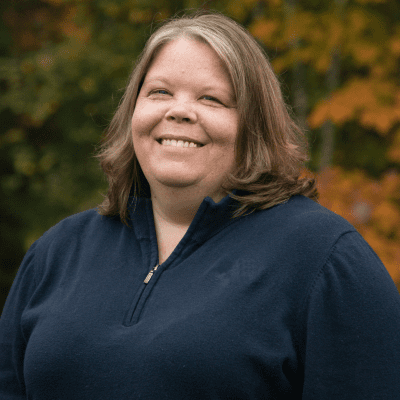As longtime foster parents with six foster and adopted children currently in their care, Stephanie Moores and her husband Todd of Milbridge know that counseling is a crucial part of helping displaced, often traumatized children adjust.
But in recent years, they have found that linking their children with an in-person therapist is almost impossible in Washington County, where a shortage of therapists has made teletherapy and alternative support systems the default treatments.
Wait lists for traditional face-to-face counseling can stretch out for a year — or longer. Even after waiting for months, the Moores’ still have to drive 31 miles to Ellsworth or 59 miles to Bangor to find an in-person therapist.
Stephanie Moores said meeting with someone face-to-face is crucial for their 4- and 6-year-old foster children.
“They have a very short attention span, and trying to get them to sit in front of a computer and talk to a stranger, to get to know them and build trust is a difficult thing,” said Moores. “They think they’re just watching TV.”

For Moores, the shortage of therapists is frustrating both personally and professionally. As the community and family engagement program manager for the Maine Seacoast Mission, one of her jobs is finding mental healthcare professionals for people seeking referrals. Since COVID, Moores said the already dire shortage of therapists has gotten worse, and the wait times longer, leaving her with scant options for people who are struggling.
“They finally reach out and I have to tell them, you know, try this place, or you can try this place,” Moores said. “It just gets really frustrating to have to say, you know, I wish you luck.”
Of the 4,634 fully or conditionally registered clinical social workers in Maine, only 3,666 live in the state, with just 47 in Washington County, compared to 121 in neighboring Hancock County, according to the Maine Department of Professional and Financial Regulation. Additional non-clinical social workers provide case management and other client services; there are 2,159 statewide and 56 in Washington County.
The department, however, noted that in both groups some licensees might not be practicing in Maine. Since COVID, counseling agencies report that many therapists have retired, scaled back or transitioned to teletherapy. Some are working out of state, although that data is not tracked.
The shift from direct, face-to-face therapy is leaving smaller agencies struggling to compete amid inadequate insurance reimbursements, and dwindling numbers of in-person, full-time therapists — or none at all.
Some agencies, including Sweetser, one of Maine’s largest nonprofit mental health providers, have been forced to close facilities. Staffing shortages can be one contributor, caused in part by low pay; the median annual wage for all social workers, as of May 2021, was $50,390, according to the Bureau of Labor Statistics. Coupled with high student loan debt, upwards of $76,000, according to the National Association of Social Workers, many therapists are being driven out of the profession or turning to better options.
Tenacious recruitment by large national counseling affiliates are luring therapists into teletherapy, where the pay is better, and they can pick and choose who they see online from the comfort of their home.
Julie Redding is a non-practicing, licensed clinical professional counselor and clinical director for the Community Caring Collaborative, which helps coordinate resources in the county. Redding said she gets barraged monthly with emails and calls from national affiliates. Although she’s committed to her supervisory job at the CCC, she knows some therapists who have flirted with the attractive offers.
“Golly, for the clinicians, how enticing that must sound. Anybody might entertain that kind of offer, given the challenges of working in-person, on the ground and certainly in homes,” Redding said.
Another nonprofit, Community Health and Counseling Services (CHCS), has a mission to serve anyone needing help. Prior to the pandemic, the agency’s Machias office had two full-time therapists. Now there’s one part-timer. Of their nine locations around the state, rural Washington County, the poorest in the state with a nearly 19 percent poverty rate, is the toughest place to recruit, according to Lori Wilson, the CHCS manager of community services.
Empty offices are now “staffed” with teletherapy equipment, where Machias’ 16 teletherapy patients can have sessions online with a CHCS therapist from various locations around the state. Wilson said they are doing everything they can to meet a client’s mental health needs.
“Our administrative assistant checks them in and gets them set up in the office with the iPad, so they have privacy and connectivity,” Wilson said. “It’s not ideal, but it’s forced us to try to be a little bit more creative in the way we look at delivering therapy services.”
But it’s not only children like Moores’ foster kids for whom teletherapy is “not ideal.” Jeremy Hewes, 48, a veteran who suffers from ADHD, depression and anxiety, received counseling in-person through the Veterans Administration until the pandemic. Faced with the same realities as the civilian sector, the VA shifted much of its mental health services online. Hewes has all but stopped “seeing” his counselor — who lives in Vermont.
“It’s just a muddled mess,” Hewes said. “They expect these counselors to do troubleshooting on their computer, trying to figure out how to make the software and hardware work. And it’s not just poor internet connections, there’s no social connection.”
Nonetheless, professionals say teletherapy is here to stay. At Sunrise Opportunities, which serves the county’s adults and children with intellectual disabilities, the in-person staff plummeted from seven to four therapists over the past couple of years. That number includes Cory Schwinn, the clinical director who splits his time between administration and counseling. Schwinn said the landscape has simply changed.
“People are really moving on and moving out, and we just haven’t seen a lot of professionals coming back into the area to replace those folks,” Schwinn said. “I’ve recruited clinicians for a long time, and this is the longest dry spell that I’ve seen in over 20 years.”
Of those still practicing independently or in-person with a local agency, many only offer teletherapy or only work part-time to prevent burnout. Kandi Robertson is a licensed clinical social worker in Milbridge who uses both in-person and teletherapy to counsel clients. But not as many as she used to. After carrying a heavy caseload for an agency, Robertson shifted to a private, part-time practice, seeing only 22 clients a week. She said it’s healthier for her and her clients.
“I am not going to give poor care to somebody, so I have to have really good boundaries,” Robertson said. “If I take on more than what I can do, then I’m spread super thin and I’m just another revolving door.”

Increasing demand and decreasing access for mental health treatment is raising concerns across the state, but especially in rural areas like Washington County, where even teletherapy can require long waits. According to the recently released 2022 Maine Shared Community Health Needs Assessment Report, mental health was the No. 2 priority in the county, second only to access to all healthcare.
The report found that county residents seek mental health care in emergency rooms at significantly higher rates than in Maine overall. Depression rates among middle school students were also significantly higher in Washington County, 35.2 percent compared to 24.8 percent statewide. Plus, 22.6 percent of Washington County middle school students reported seriously considering suicide compared to 19.8 percent statewide.
RELATED: 40 percent of high schoolers report mental health problems
Gaps and needs in Washington County included inadequate services; lack of continuity; not enough providers; wait lists; barriers to treatment, such as lack of transportation and broadband; and not being able to access a “real person.” Alternatives, such as emerging school-based teletherapy programs and federally funded certified community behavioral health centers are helping to fill the gap.
Community behavioral health centers use a team of professionals, such as non-clinical social workers, to provide an array of mental health supports, including teletherapy, screening, case management, peer groups, crisis and veterans’ services. Although access to a licensed clinical therapist is still limited, professionals say the centers are a comprehensive response to the escalating mental health crisis.
Evidence of the crisis is clear in one small town in far-flung northeastern Washington County. Baileyville was devasted after four young people died by suicide, including a 14-year-old boy, in the winter of 2021, as reported by The Maine Monitor. Those suicides and an opioid epidemic claiming lives from overdoses put Baileyville and what some call “The Forgotten Country” in the undesired mental health spotlight.
The Maine Department of Health and Human Services (DHHS) was awarded a $1 million federal grant this month to develop additional centers across the state. The grant is only a fraction of the federal and state money being spread among communities in Maine.
A DHHS spokesperson said the governor’s budget proposal for the 2024-25 biennium includes $237 million for behavioral health services and payment rate increases, adding to the $230 million invested in behavioral health services in the 2022-23 biennium. It includes $17 million to address the urgent need to expand the range of services for children’s behavioral health. Also, $36.8 million of one-time payments was spread out among behavioral health providers, according to the agency’s director of communications, Jackie Farwell.
“Strengthening Maine’s behavioral health system is a priority for Maine DHHS under the Mills administration,” Farwell said. “Every budget signed into law by Gov. Mills has increased funding for behavioral health, and DHHS has worked to bridge gaps in Maine’s behavioral health continuum of services, including supporting a new system and staff.”
Towns such as Baileyville couldn’t wait. In 2022, its Woodland Schools (AOS 90) signed onto a school-based, teletherapy program run by AMHC and St. Croix Health, with a mix of funding and support, in part from insurance provider Point32 (formerly Harvard Pilgrim) and Hallowell-based MCD Global Health, a public health nonprofit. Jonesport-Beals schools began rolling out the program this month.
AOS 90 Superintendent Patricia Metta, who at first was skeptical, said the program, quite literally, has been a lifesaver in Baileyville, where youth suicides last year dropped to zero.
“Our kids were dying, they were dying,” Metta said. “When COVID hit they just dropped off the face of the earth; they got so used to staying in their homes and wrapping up within themselves.”
RELATED: How Baileysville rallied to increase peer support
The program uses non-credentialed, adult “navigators,” also known as community health workers, to escort students to private rooms within the schools for their teletherapy sessions. An in-person therapist is available on a limited basis. AMHC navigators need only a high school degree.
The qualifications of the navigators concern some professionals, such as Lori Schneiders, a PhD psychology professor at the University of Maine at Machias, who educates certified mental health professionals.
“They definitely are putting people not qualified in those positions,” Schnieders said. “My fear is that somebody’s going to give some advice and a kid is going to wind up committing suicide.”
School officials argue that navigators and teletherapy programs are filling a desperate need and working well, with students eager to participate. Similarly, community behavioral health centers, which rely on non-clinical social workers and teletherapy, are meeting urgent needs with vital services — and will soon, according to professionals, become the predominant model. Still, the new systems simply aren’t a solution for many like Hewes, who says the “team” approach doesn’t work for him, and there’s still a wait for in-person counseling.
There are state and local efforts addressing the shortage of therapists, including $20 million allocated statewide to support workforce training, and in Washington County the creation of the Community Caring Collaborative Council, which brings area mental health providers together monthly to leverage resources, such as certification programs at UMM and Washington Community College.
“There’s a role for those who work within those systems to be at the same table if they’re going to come up with real, significant solutions,” Redding said.
If you or someone you know is affected by any of the issues raised in this story, call the Maine crisis hotline at 888-568-1112 or you can call or text the national hotline at 988.
Sign up here to receive The Maine Monitor’s free newsletter, Downeast Monitor, that focuses on Washington County news.





